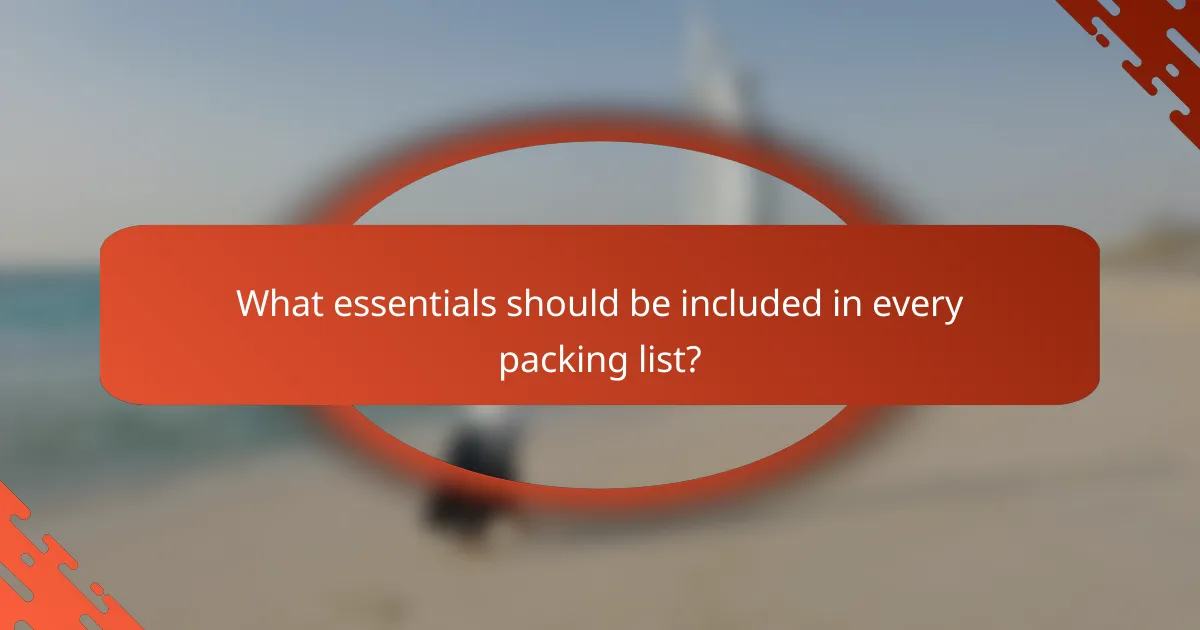Packing effectively for seasonal travel requires careful consideration of the climate and planned activities to ensure you have the right essentials while managing weight. Prioritize versatile clothing that can be layered and mixed to adapt to changing conditions, and focus on lightweight gear to enhance comfort and mobility. Always include items that guarantee your comfort, safety, and convenience, tailored to your destination’s specific needs.

What are the best packing tips for seasonal gear?
Effective packing for seasonal gear involves understanding the climate and activities planned, ensuring you have the right essentials while managing weight. Prioritize versatile items that can be layered or mixed and matched to adapt to changing conditions.
Layering techniques for winter clothing
Layering is crucial for winter clothing to maintain warmth and flexibility. Start with a moisture-wicking base layer to keep sweat away from your skin, followed by an insulating layer like fleece or down to trap heat, and finish with a waterproof and windproof outer layer.
When packing, choose lightweight materials that provide warmth without bulk. Avoid cotton, as it retains moisture; instead, opt for synthetic or wool fabrics. A good rule of thumb is to pack one base layer and one insulating layer for each day of your trip, plus an extra set.
Essential summer gear for beach trips
For beach trips, essential summer gear includes swimwear, sunscreen, and a wide-brimmed hat. Lightweight clothing made from breathable fabrics is also important to stay cool under the sun. Consider packing a beach towel and a reusable water bottle to stay hydrated.
When packing, aim for items that can serve multiple purposes, such as a sarong that can be used as a cover-up or picnic blanket. A good checklist includes swimwear, flip-flops, sunglasses, and a waterproof bag for wet items.
Fall packing strategies for hiking
In fall, packing for hiking requires attention to changing weather conditions. Bring moisture-wicking layers, a warm hat, and gloves, as temperatures can drop significantly during hikes. A waterproof jacket is essential to protect against unexpected rain.
Consider packing a lightweight backpack that can accommodate extra layers and snacks. A useful strategy is to pack a small first-aid kit and a map or GPS device, ensuring you are prepared for any situation while enjoying the autumn scenery.
Spring essentials for outdoor activities
Spring outdoor activities often involve unpredictable weather, so pack layers that can be easily added or removed. Lightweight jackets, breathable shirts, and quick-drying pants are ideal for this season. Don’t forget to include insect repellent and a hat for sun protection.
When planning your packing list, consider versatile items that can transition from cool mornings to warmer afternoons. A compact umbrella can also be a smart addition for unexpected rain showers, ensuring you stay comfortable during your adventures.

How to manage weight when packing?
Managing weight when packing is crucial for comfort and mobility during your travels. Focus on selecting lightweight gear, versatile clothing, and ensuring you know the weight of your items before you leave.
Using a lightweight backpack
A lightweight backpack is essential for reducing overall weight. Look for materials like nylon or polyester that offer durability without bulk. Aim for a pack that weighs around 1-2 kg, allowing you to carry more without straining your back.
Consider features such as adjustable straps and ventilation to enhance comfort. A well-fitted backpack can distribute weight evenly, making it easier to carry for extended periods.
Choosing multi-use clothing items
Selecting multi-use clothing can significantly reduce packing weight. Opt for items that can serve multiple purposes, such as a pair of pants that can convert into shorts or a jacket that doubles as a raincoat. This approach minimizes the number of clothing items you need to bring.
Choose fabrics that are lightweight, quick-drying, and wrinkle-resistant. Merino wool or synthetic blends are often good choices, as they can be worn multiple times without needing a wash.
Weighing your gear before departure
Weighing your gear before you leave helps ensure you stay within a comfortable carrying limit. Use a digital scale to check the weight of each item, aiming for a total pack weight of around 10-15% of your body weight for optimal comfort.
Create a checklist of your gear and its weights to identify any unnecessary items. This practice not only helps in weight management but also ensures you are prepared for your trip without overpacking.

What essentials should be included in every packing list?
Every packing list should include items that ensure comfort, safety, and convenience during your travels. Essentials typically encompass clothing, travel documents, personal items, and gear tailored to the destination’s climate and activities.
Must-have travel accessories
Travel accessories enhance convenience and organization. Key items include a durable suitcase or backpack, packing cubes for organization, and a portable charger to keep devices powered. Consider a travel pillow for comfort during long journeys and a reusable water bottle to stay hydrated.
Additionally, noise-canceling headphones can improve your travel experience by blocking out distractions. A travel umbrella is also a smart choice, especially in unpredictable weather conditions.
First aid kit essentials
A well-stocked first aid kit is crucial for handling minor injuries and ailments while traveling. Include adhesive bandages, antiseptic wipes, pain relievers, and any personal medications you may need. It’s wise to have a few basic tools like scissors and tweezers as well.
For specific destinations, consider adding items like insect repellent or allergy medication. Always check local regulations regarding medical supplies to ensure compliance.
Toiletries for different climates
Your toiletries should cater to the climate of your destination. In humid areas, lightweight, quick-drying products are beneficial, while in dry climates, opt for moisturizing lotions and lip balms. Travel-sized containers can help save space and comply with airline regulations.
Don’t forget sun protection, such as sunscreen and sunglasses for sunny destinations, and consider packing a small towel if you’re headed to the beach or a pool. Always check local customs regarding the import of certain toiletries, especially those containing specific chemicals.

How to pack efficiently for different destinations?
Packing efficiently for various destinations involves understanding the unique requirements of each location. Consider factors such as climate, activities, and duration of stay to tailor your packing list accordingly.
Urban packing tips for city trips
When packing for city trips, prioritize versatility and comfort. Choose clothing that can be mixed and matched, and opt for lightweight, wrinkle-resistant fabrics. A compact daypack can hold essentials like a water bottle, snacks, and a portable charger.
Don’t forget to include comfortable walking shoes, as city exploration often involves a lot of walking. Aim for a packing limit of around 7-10 outfits for a week-long trip, ensuring you have layers for varying weather conditions.
Camping gear for national parks
Packing for camping in national parks requires careful selection of gear to ensure safety and comfort. Start with a sturdy tent, sleeping bag, and sleeping pad, and consider the season to choose appropriate insulation levels.
Include essential cooking gear, such as a portable stove, utensils, and non-perishable food items. A checklist can help you remember items like a first aid kit, flashlight, and multi-tool, ensuring you have everything for a successful outdoor experience.
Beach packing checklist for coastal vacations
For beach vacations, focus on items that enhance relaxation and fun. Pack essentials like sunscreen, towels, and swimwear, along with a beach umbrella or portable chair for comfort. A waterproof bag can protect your valuables from sand and water.
Consider bringing snacks and a cooler for drinks to stay refreshed throughout the day. A simple checklist might include flip-flops, a hat, sunglasses, and a good book to enjoy while soaking up the sun.

What are the best practices for packing fragile items?
To effectively pack fragile items, prioritize protection and organization. Use appropriate materials and techniques to minimize the risk of damage during transport.
Using bubble wrap for protection
Bubble wrap is an excellent choice for safeguarding fragile items. Wrap each item individually, ensuring that the bubbles face inward to cushion the surface. For added protection, consider using multiple layers of bubble wrap for particularly delicate objects.
When using bubble wrap, secure it with packing tape to prevent it from unwrapping. Avoid overpacking items in a single box, as this can lead to pressure and potential breakage.
Choosing the right luggage for fragile gear
Select luggage that offers adequate protection for fragile gear. Hard-shell suitcases provide better impact resistance compared to soft-sided bags, making them ideal for delicate items. Look for luggage with padded compartments or dividers to keep fragile items secure during travel.
Consider the size and weight of your luggage as well. Ensure that it meets airline regulations if you are flying, and remember that lighter luggage can help you manage weight limits more effectively.
Labeling boxes for easy handling
Labeling boxes containing fragile items is crucial for their safe handling. Use clear, bold labels that indicate “Fragile” on all sides of the box to alert handlers. This simple step can significantly reduce the risk of mishandling during transport.
Additionally, consider using color-coded labels for different types of fragile items. This can help you and others quickly identify contents and prioritize careful handling, especially in busy environments like airports or moving trucks.

How to adapt packing strategies for international travel?
Adapting packing strategies for international travel involves understanding the unique requirements of your destination and the duration of your trip. Consider factors such as climate, cultural norms, and local regulations to ensure you pack efficiently and appropriately.
Seasonal Gear Considerations
When traveling internationally, seasonal gear is crucial. Research the climate of your destination during your travel dates to determine what clothing and equipment are necessary. For example, if visiting a tropical region, lightweight, breathable fabrics are essential, while colder destinations require insulated layers.
Consider versatile clothing that can be layered or mixed and matched to reduce bulk. A good rule of thumb is to pack items that can serve multiple purposes, such as a jacket that can be worn both casually and formally.
Essential Items to Pack
Essential items for international travel include travel documents, medications, and personal hygiene products. Always carry your passport, visas, and any necessary identification in a secure, easily accessible location.
Additionally, pack a small first-aid kit and any prescription medications you may need. Toiletries should be travel-sized to comply with airline regulations, and consider including a reusable water bottle to stay hydrated.
Weight Management Tips
Managing weight is vital when packing for international travel, especially with airline baggage restrictions. Aim to keep your luggage within the allowed limits, typically around 20-30 kg for checked bags, to avoid extra fees.
Use a digital luggage scale to weigh your bags before heading to the airport. Packing cubes can help organize items and maximize space, making it easier to manage weight distribution. Remember to leave room for souvenirs or items you may acquire during your trip.


